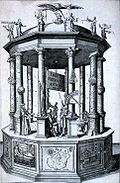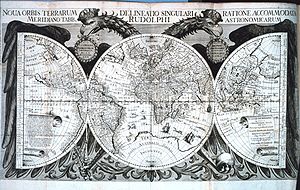
Rudolphine Tables
Encyclopedia

Star
A star is a massive, luminous sphere of plasma held together by gravity. At the end of its lifetime, a star can also contain a proportion of degenerate matter. The nearest star to Earth is the Sun, which is the source of most of the energy on Earth...
catalogue and planetary tables published by Johannes Kepler
Johannes Kepler
Johannes Kepler was a German mathematician, astronomer and astrologer. A key figure in the 17th century scientific revolution, he is best known for his eponymous laws of planetary motion, codified by later astronomers, based on his works Astronomia nova, Harmonices Mundi, and Epitome of Copernican...
in 1627 using data from Tycho Brahe
Tycho Brahe
Tycho Brahe , born Tyge Ottesen Brahe, was a Danish nobleman known for his accurate and comprehensive astronomical and planetary observations...
's observations.
Previous tables
Star tables had been produced for many centuries and were used to establish the position of the planets relative to the fixed stars (particularly the twelve constellations used in astrologyAstrology
Astrology consists of a number of belief systems which hold that there is a relationship between astronomical phenomena and events in the human world...
) on a specific date in order to construct horoscope
Horoscope
In astrology, a horoscope is a chart or diagram representing the positions of the Sun, Moon, planets, the astrological aspects, and sensitive angles at the time of an event, such as the moment of a person's birth. The word horoscope is derived from Greek words meaning "a look at the hours" In...
s. Until the end of the 16th century, the most widely used had been the Alphonsine tables, first produced in the 13th century and regularly updated thereafter. These were based on a Ptolemeic
Ptolemy
Claudius Ptolemy , was a Roman citizen of Egypt who wrote in Greek. He was a mathematician, astronomer, geographer, astrologer, and poet of a single epigram in the Greek Anthology. He lived in Egypt under Roman rule, and is believed to have been born in the town of Ptolemais Hermiou in the...
, geocentric model of the solar system. Although the Alphonsine tables were not very accurate, nothing else was available and so they continued to be used.
In 1551, following the publication of De revolutionibus orbium coelestium
De revolutionibus orbium coelestium
De revolutionibus orbium coelestium is the seminal work on the heliocentric theory of the Renaissance astronomer Nicolaus Copernicus...
by Nicholas Copernicus, Erasmus Reinhold
Erasmus Reinhold
Erasmus Reinhold was a German astronomer and mathematician, considered to be the most influential astronomical pedagogue of his generation. He was born and died in Saalfeld, Saxony....
produced the Prutenic Tables
Prutenic Tables
The Prutenic Tables , were an ephemeris by the astronomer Erasmus Reinhold published in 1551. They are sometimes called the Prussian Tables after Albert I, Duke of Prussia, who supported Reinhold and financed the printing...
based on a heliocentric model of the solar system, but these were no more accurate than the earlier tables.
Brahe's data and Kepler's model of the solar system
Tycho Brahe had spent much of his life obtaining measurements of the position of stars and planets to a much greater accuracy than had been possible previously. He wished these observations to be the basis of a new and more accurate set of star tables. Kepler was able to prepare these new tables using Brahe's accurate observations together with a heliocentric model of the solar system and his own discovery of the elliptical orbits of the planets. Accurate calculation was aided by the newly published system of logarithmLogarithm
The logarithm of a number is the exponent by which another fixed value, the base, has to be raised to produce that number. For example, the logarithm of 1000 to base 10 is 3, because 1000 is 10 to the power 3: More generally, if x = by, then y is the logarithm of x to base b, and is written...
s which simplified accurate calculation and made them less prone to errors.
Publication

Brahe had intended that the tables should be dedication to Emperor Rudolf II
Rudolf II, Holy Roman Emperor
Rudolf II was Holy Roman Emperor , King of Hungary and Croatia , King of Bohemia and Archduke of Austria...
, but by 1627 when the tables were published, he had died, so instead they were dedicated to Emperor Ferdinand II but are named after Rudolph. They contain positions for the 1,006 stars measured by Tycho Brahe
Tycho Brahe
Tycho Brahe , born Tyge Ottesen Brahe, was a Danish nobleman known for his accurate and comprehensive astronomical and planetary observations...
, and 400 and more stars from Ptolemy
Ptolemy
Claudius Ptolemy , was a Roman citizen of Egypt who wrote in Greek. He was a mathematician, astronomer, geographer, astrologer, and poet of a single epigram in the Greek Anthology. He lived in Egypt under Roman rule, and is believed to have been born in the town of Ptolemais Hermiou in the...
and Johann Bayer
Johann Bayer
Johann Bayer was a German lawyer and uranographer . He was born in Rain, Bavaria, in 1572. He began his study of philosophy in Ingolstadt in 1592, and moved later to Augsburg to begin work as a lawyer. He grew interested in astronomy during his time in Augsburg...
, with directions and tables for locating the planet
Planet
A planet is a celestial body orbiting a star or stellar remnant that is massive enough to be rounded by its own gravity, is not massive enough to cause thermonuclear fusion, and has cleared its neighbouring region of planetesimals.The term planet is ancient, with ties to history, science,...
s of the solar system
Solar System
The Solar System consists of the Sun and the astronomical objects gravitationally bound in orbit around it, all of which formed from the collapse of a giant molecular cloud approximately 4.6 billion years ago. The vast majority of the system's mass is in the Sun...
. The tables included many function tables of logarithm
Logarithm
The logarithm of a number is the exponent by which another fixed value, the base, has to be raised to produce that number. For example, the logarithm of 1000 to base 10 is 3, because 1000 is 10 to the power 3: More generally, if x = by, then y is the logarithm of x to base b, and is written...
s and antilogarithms, and instructive examples for computing planetary positions.
For most stars these tables were accurate to within one arc minute
Minute of arc
A minute of arc, arcminute, or minute of angle , is a unit of angular measurement equal to one sixtieth of one degree. In turn, a second of arc or arcsecond is one sixtieth of one minute of arc....
, and were the first to include corrective factors for atmospheric refraction
Atmospheric refraction
Atmospheric refraction is the deviation of light or other things like humanelectromagnetic wave from a straight line as it passes through the atmosphere due to the variation in air density as a function of altitude...
. The tables were sufficiently accurate to predict a transit of Mercury
Transit of Mercury
A transit of Mercury across the Sun takes place when the planet Mercury comes between the Sun and the Earth, and Mercury is seen as a small black dot moving across the face of the Sun....
observed by Pierre Gassendi
Pierre Gassendi
Pierre Gassendi was a French philosopher, priest, scientist, astronomer, and mathematician. With a church position in south-east France, he also spent much time in Paris, where he was a leader of a group of free-thinking intellectuals. He was also an active observational scientist, publishing the...
in 1631 and a transit of Venus
Transit of Venus
A transit of Venus across the Sun takes place when the planet Venus passes directly between the Sun and Earth, becoming visible against the solar disk. During a transit, Venus can be seen from Earth as a small black disk moving across the face of the Sun...
observed by Jeremiah Horrox in 1639.
External links
- Universitätsbibliothek Kiel – Digiport: Tabulæ Rudolphinæ - BartschJakob BartschJakob Bartsch or Jacobus Bartschius was a German astronomer.-Biography:Bartsch was born in Lauban in Lusatia. He was taught how to use the astrolabe by Sarcephalus , a librarian in Breslau...
version from 1627, with appendices on Schiller's Christian constellations and Bartsch'es own constellation innovations. - Johannes Kepler, Tabulae Rudolphinae

